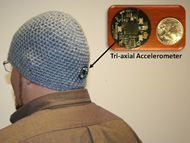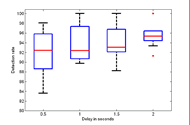Sreekar Krishna, Narayanan Krishnan and Sethuraman Panchanathan
Center for Cognitive Ubiquitous Computing (CUbiC), School of Computing and Informatics (SCI), Arizona State University, Tempe AZ 85281
ABSTRACT
In this paper, we propose the use of an on-body tri-axial accelerometer, as an assistive technology for the detection of stereotypic body rocking behavior. We introduce state-of-the-art technology in motion capture and demonstrate its use for detecting stereotypic body rocking behavior and its capacity to differentiate body rocking from other movements. The results are encouraging to motivate the use of accelerometers for building rehabilitative devices for individuals who have other stereotypic body
KEYWORDS
Accelerometers, stereotypic body behaviors, body rocking, physical and cognitive impairments
INTRODUCTION
Stereotypic behavior refers to any mannerism that is non functional and repetitive in nature. Examples of this behavior include, body rocking, head weaving, head drooping, eye poking, and repetitive vocal behaviors (1) Stereotypy can become a hindrance to social interactions and social acceptance thereby affecting the professional and personal lives of individuals. (2) shows through an independent vocational evaluation the necessity in reduction of stereotypic body rocking in a 21 year old congenitally blind student for any employment considerations. Stereotypy is also a concerning problem in children, for whom, peer acceptance is very important for their healthy growth and development of good social skills. Children with stereotypic behaviors become victims of teasing by other children leading to negative self esteem and social segregation. Supporting these cases, many psychology studies have shown that poor social skills are a leading cause for psychological problems such as depression, loneliness, and social anxiety. Broad classes of stereotypic body behaviors have been identified in individuals having different physical or cognitive impairments. Eichel (3) introduces taxonomy of mannerisms that people with blindness and visual impairment tend to display and identifies that body rocking as one of the most commonly seen behavior stereotype. A review of literature further supports the claim that body rocking, followed by head related mannerisms are the distinctive stereotype behaviors exhibited by individuals. Any technology developed towards rehabilitating individuals on stereotypic body rocking would prove beneficial to the development of their overall social outlook.
RESEARCH QUESTIONS
Rehabilitation of stereotypic body rocking being the focus of this research, we propose to answer the questions:
- Is it possible to build a device that detects body rocking?
- If so, how well can it distinguish body rocking from other functional movements?
BACKGROUND AND RELATED WORK
For over three decades, researchers in behavioral psychology have studied stereotypic body rocking. The methodologies used by these researchers can be broadly classified into two important categories.
- Rehabilitation through Intervention: Researchers have attempted to reduce body rocking by providing audio and/or tactual intervention whenever an individual started to rock. Aversive punishment as well as less restrictive positive feedback like verbal praise, physical guidance, verbal reprimands, and brief time-outs has also been used as intervention strategies. All these studies report the effectiveness of intervention for reducing and controlling body rocking.
- Rehabilitation through Self Monitoring: Self monitoring is based on the idea of enabling the individual to become conscious of their behavior. (1) introduces a congenitally blind individual who was trained to count the number of body rocks he goes through. The research concludes that a well designed self monitoring program would effectively reduce stereotypic body rocking. (4) presents the case of a 12 year old child having excessive body rocking and hand flapping stereotypy. The authors introduce an elaborate and positively rewarding self monitoring scheme that allows the child to improve on his behavior effectively. A follow-up with the child’s teacher indicates that the social outlook of the child improved dramatically over the course of rehabilitation. The authors conclude that rocking can be significantly reduced through signaling combined with self monitoring.
These studies provide extensive evidence for rehabilitation of stereotypic body rocking behavior. Note that, feedback was provided to the subjects by experts in all these studies. Unfortunately, this impractical in an everyday setting when the subject is engaged in activities of daily living. An assistive or rehabilitative technology developed towards automatically detecting body rocking and differentiating it from other movements will prove to be useful for individuals with the need of rehabilitation.
(2) developed a head mounted switching device that would trigger a tone when an individual started to rock. The authors tested it on a congenitally blind individual who had severe case of body rocking. They concluded that the use of any assistive technology is useful only temporarily while the device is in use. The body rocking returned to baseline levels as soon as the device was removed. Behavioral psychology research states that short time feedback is detrimental to rehabilitation. Unfortunately, due to the prohibitively large design of the device it was impossible for the researchers to have the individual wear the device over long period. This makes the case for any technology developed for behavioral rehabilitation to be diminutive and the ability to be used over long durations. To this end, we propose the use of accelerometers for detecting body rocking and differentiating it from other movements.
PROPOSED DEVICE
Recently, inertial sensing has gained a lot of importance due to the availability of micro mechanized silicon-based electronic systems that have enabled accurate measurement of linear and rotational acceleration. When mounted on any moving member, the opposing motion (opposing gravity) of the entity allows the sensors to measure speed and direction of motion. The proposed stereotypic body rock detection device incorporates a tri-axial accelerometer to measure linear acceleration along the three mutually perpendicular spatial axes, X Y and Z. Figure 1 shows the use of such inertial sensor mounted on a hat, behind the head of a subject. The inset shows the motion sensing accelerometer package that was used in our experiments. The sensor connects wirelessly to a PDA and/or cell phone that analyzes the incoming motion patterns and detects the exact time instance of body rocking. The device (including a coin battery as a power source) is 1¼ inch in diameter and less than ¼ inch in thickness thereby allowing an elegant integration into everyday clothing. We use an AdaBoost learning algorithm framework (5) that allows the system to understand and encode motion pattern differences between activities of everyday living and stereotypic body rocking. Like other learning algorithms, our implementation has two clear steps, namely, a) the training and, b) the testing. Training is done offline on recorded data of rocking and non-rocking behavior, while the testing is done on streaming data from the accelerometers.
EXPERIMENTS
Experiments were carried out on 10 participants who did not have any known stereotype rocking behavior. The goal of the experiments was to collect data for training the system to differentiate rocking from non-rocking behavior. To this end, we devised three separate data collection routines where the subjects were required to do rocking and non-rocking tasks as naturally as possible. The details of the routines are as follows:
Routine A:
Rocking data: Participants were allowed to choose from a rocking chair or a stool or sitting on the ground, so they could rock as comfortably and naturally as possible. We found some cultural preferences to the way people choose to rock. The subjects were asked to rock for a total of 20 complete cycles.
Routine B:
Non-rocking data: The participants were asked to do activities that did not involve rocking. They moved around the setup reading posters, operating computers, interacting with everyday office equipments and included some functional body motions similar to rocking like, stooping down to pick up objects, rapidly bending down to pick up objects etc. Data was collected for a total of 30 seconds.
Routine C:
Test data: Since rocking can happen at any given instance, we collected data where subjects did various activities and interspersed them randomly with rocking. The goal is to determine how fast and accurately our system can detect such rocking occurrences.
Experiment:
Data from routine A was used as positive rocking samples while data from routine B was used as negative samples in training our system. The system was then tested on data from routine C. Data stream from the sensor was divided into packets and each packet was classified as belonging to rocking or non-rocking instance. Four trials were carried out with packet length of duration 0.5, 1, 1.5 and 2 seconds.
RESULTS
The efficiency of the system was measured using accuracy and latency metrics. Accuracy is the ability to correctly detect rocking, while latency is the time difference between subject rocking and the system detecting it. Figure 2 shows the box plot of rocking detection experiments over 10 subjects. The abscissa is the data stream packet length (latency metric) and ordinate is the detection rate (efficiency metric). The red lines show the median rocking detection rate among the subjects under different latencies. The blue box indicates detection capacity within the upper and lower 25 percentile on all the tests. The variance extremities are represented by the dotted line extensions and any outlier in data is highlighted by the red markers.
DISCUSSION AND CONCLUSION
From Figure 2 it can be seen that the best performance of our device was to detect rocking from non-rocking on an average of 95% with a latency of 2. It was possible to detect rocking at a much less latency (0.5s), but the detection rate went down to 92%. Thus, 95% of the time, we could inform a subject of his/her rocking activity within 2 seconds of them starting to rock. Further, we noticed that the average natural rocking motion of all 10 subjects was around 27 rocks a minute (i.e. 27 rocks in 60 seconds or 2.22 seconds per rock), which implies that a latency of 2 seconds was well within the time duration of a single rocking action.
We noticed that the variance of recognition rate between the 10 subjects was an inverse linear variant of the latency. Higher the latency, lesser was the variance and hence higher the chance of detecting rocking on all subjects. Thus, it is better to operate at higher latency and achieve rocking detection on most subjects.
The graph, though plotted for rocking detection efficiency, can be also interpreted as the ability of the system to distinguish rocking from other movements. Thus, we can conclude that our device was capable of detecting stereotypic rocking action within one rock cycle while still maintaining the ability to discriminate rocking from other activities.
Future efforts are focused on working with subjects who have stereotypic rocking and determining ways to provide intervention and well devised self-monitoring tools.
REFERENCES
- McAdam, D.B. and O'Cleirigh, C. M. (1993). Self-monitoring and verbal feedback to reduce stereotypic body rocking in a congenitally blind. Re:View, 24(4), 163.
- Transon, R.E. (1988). Using the feedback band device to control rocking behavior. Journal of Visual Impairment & Blindness, 82, 287-289.
- Eichel, V. J. (1978). Mannerisms of the blind: A review of the literature. Journal of Visual Impairment & Blindness, 72, 125-130.
- Shabani, D.B., Wilder, D. A., & Flood, W. A. (2001). Reducing stereotypic behavior through discrimination training, differential reinforcement of other behavior, and self-monitoring. Behavioral Interventions, 16(4), 279-286.
- Krishnan, N. and Panchanathan, S. (2008). Analysis of low resolution accelerometer data for continuous human activity recognition. In IEEE International Conference on Acoustics, Speech and Signal Processing, 2008. ICASSP 2008. (pp. 3337-3340).
ACKNOWLEDGEMENTS
We acknowledge all participants of the experiment and undergraduate researcher Colin Juillard.
Author Contact Information:
Sreekar Krishna, MS, Arizona State University, 699. . Mill Ave, Tempe AZ 85281, Office Phone: (480) 727-3612, EMAIL: Sreekar.Krishna@asu.edu

